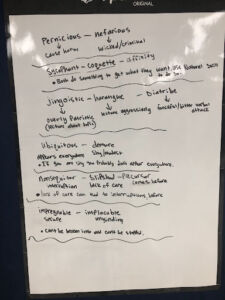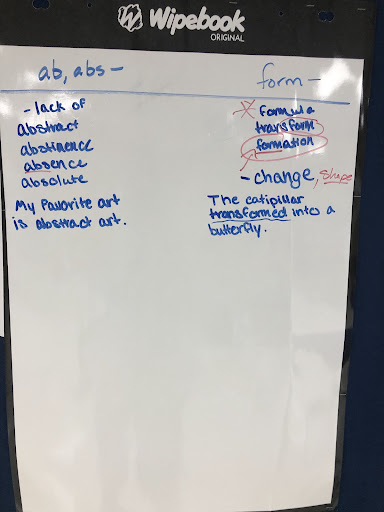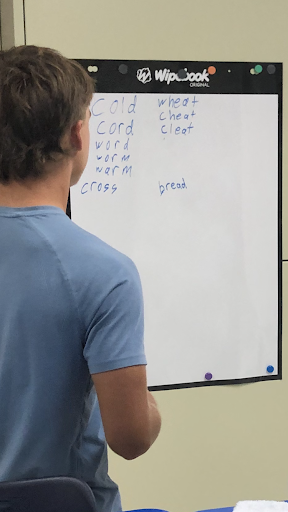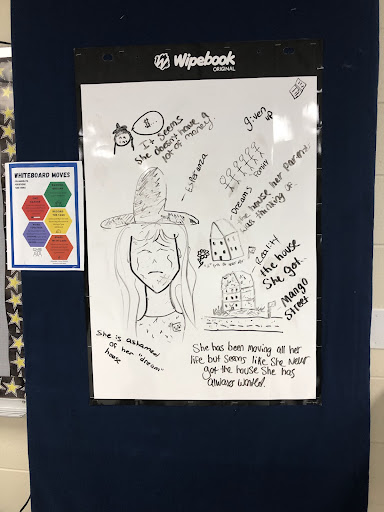Have you heard the joke about the English teacher who walked into a math conference looking for ways to change his teaching? Yeah, me neither, but that is exactly what happened when I attended the Building Thinking Classrooms (BTC) Conference during the summer of 2023. I walked in knowing very limited information about BTC and had not read Peter Liljedahl’s book at that point. However, I immediately found myself immersed in educators who were raving about how the frameworks were transforming their classrooms and the thinking they saw from their students after implementing BTC frameworks. I knew I had to learn more.
The conference’s unique setup had me immersed in the BTC frameworks each session. As a participant, I was up working at whiteboards around the room with random groups working on rich tasks which allowed me to see the frameworks in practice firsthand. It was unlike any education conference I have attended. I still had a lot of questions of how these frameworks function in other disciplines. As the conference wrapped up, I had the Building Thinking Classrooms book in hand, a plethora of notes to review, and a new network of teachers to connect with for guidance.
The First Six Weeks
My experience implementing the BTC frameworks into my ELA courses during the first weeks of school was nerve-wracking at first, but I have been pleasantly surprised by the engagement and thinking that has occurred. It is still a work in progress. I continually find myself thinking how I can change lessons to adopt more of the BTC frameworks in the future. I still find myself struggling to create rich thinking tasks. I want to get better at this before fully moving out of the toolkit. I have tried a few of the other framework elements and hope to reflect on those in the future.
“I continually find myself thinking how I can change lessons to adopt more of the BTC frameworks in the future.”
With guidance from other BTC teacher’s and Peter Liljedahl from the conference, I decided I would only focus on the first toolkit to start which includes engaging students in a thinking task, randomized groups, and vertical non-permanent surfaces(VNPS). My goal was to include these at least once each week.
- THINKING TASKS
- Curricular tasks have come from material that I’ve used in my classes from previous years. I use a target standard or an anchor text as my guidance for creating the task.
- Non-Curricular tasks are used as bell ringers to activate thinking in my classes and to help us build proofreading, analysis, or critical thinking mindsets to name a few.
- There are storehouses of tasks available for teachers in the realm of mathematics where BTC originated. However, there is a movement in other disciplines to adopt the frameworks with a vibrant ELA community growing on Facebook. The more I shift my classroom culture and consider what I want my students to do through the lens of thinking tasks the easier they are to create.
- RANDOMIZED GROUPS
- For randomized grouping, I’ve continued to use playing cards as a way to distribute groups. It allows me to have a quick interaction with all of my students to start the class period (which helps me remember attendance!).
- This process was a bit clunky at first, but my students know the process now and are up and moving to their stations once they see what card they draw. The key to this, for me at least, has been making sure to get the students up and at one of the boards as a whole group for my verbal directions. There are times that students tried to switch cards without my knowledge. I try to use this as a time to share why being with different classmates is important for our thinking.
- VERTICAL NON-PERMANENT SURFACES
- There are several resourceful ways that a teacher can create these non-permanent surfaces in their classrooms. I was able to purchase some from the company Wipebooks, but there are several DIY options. As Liljedahl stresses in the book, it is important that the boards can be easily erased to allow students to take risks during their thinking.
- Having students at the vertical stations gets students engaged as they are standing throughout the thinking task.
General Observations

Students who are in my classes that are traditionally labeled as advanced courses have struggled the most with this framework and have provided the most pushback on implementation. As I reflected on the Building Thinking Classrooms book, I attribute this resistance due to their skills at mimicking through the course of their time in the classroom.
During one of my sections of sophomores with students who I had last year, they shared at the end of one of our classes that they liked the way I was teaching this year and liked being able to get up and move around more. This opened the door to a discussion about what I was trying and how I was hoping to engage them in more thinking tasks this school year.
During my first task rollout, I had students get up and come to the front for verbal directions before randomizing the groups. After directions and randomizing, students went to their stations to get started. I could tell many groups were uncertain of where to start. I wanted to stop and give more directions, but I knew from Liljedahl’s guidance that this could stop the thinking altogether. This happened on another occasion, but I saw my students working through the productive struggle that allowed them to work as a group to achieve the thinking task.
Seats are still available in my classroom as I continue to grow in my implementation of the BTC model, but I have noticed that if seats are close to the VNPS stations students immediately want to sit down in the chair.
Tasks I’ve used so far:
Word Ladders (non-curricular)
This asks students to do some word work as they try to change one word into another word by changing one letter at a time for each line moving down. This has them engage in conversation about words (“Is this a real word?”) as they try to change letters one by one. I used this as a bell ringer to introduce the BTC model and to help them work on their critical thinking skills.
Vocab Thinking Task
My honors students get 5 SAT words a week and then after 3 weeks we review them and they have a small assessment where they have to use words in context. In order to help them grow their understanding and not just have a definition memorized, I posted all 15 words and their definitions next to the whiteboards in my room. I then asked them to create a word map to connect the words. Their connections had to be labeled, but they could find ways such as synonyms, antonyms, definitions, roots, etc. to make connections.
Roots Work
I provided two roots per whiteboard and asked the groups to write down words they thought used that root, they were to come up with a definition based on the words they identified, and then use one of them in a sentence. We do gallery walks for consolidation and I have different students explain what they see and if they think the definition fits until we come up with a collective group definition that fits.
Character Analysis
In my class, I used excerpts from Sandra Cisneros’ book The House on Mango Street to complete this task. However, it could be completed with any text. Here is the task I gave my students: We are going to explore and create a character identity based on what we read from the first chapter of The House on Mango Street. Imagine you are an artist who has to create an identity for our main character (Esperanza). Using both words and images, create a representation of what you know and what you believe to be true about our character on your whiteboards.



“I’ve watched as my quiet students take on leadership roles and help guide the thinking in their small, randomized groups.”
As I continue to grow in my use of the BTC model, I keep focus on what is going to challenge my students’ thinking and how will that thinking move the class forward to understanding a specific concept. I’ve watched as my quiet students take on leadership roles and help guide the thinking in their small, randomized groups. I’ve witnessed great reflection on tasks as I ask students from other groups to share what they see from their peers’ boards during gallery walks and consolidation. So far, the tasks have been led and introduced by the teacher. I hope to expand to provide more tasks for students to move through on their own as they finish. What I know after using the BTC framework for the first six weeks is that I see a difference in the engagement of my students and that gives me motivation to continue to learn and grow in my understanding of the BTC framework and its place in my classes for the rest of year.
Resources
Please login or register to claim PGPs.
Alternatively, you may use the PGP Request Form if you prefer to not register an account.



